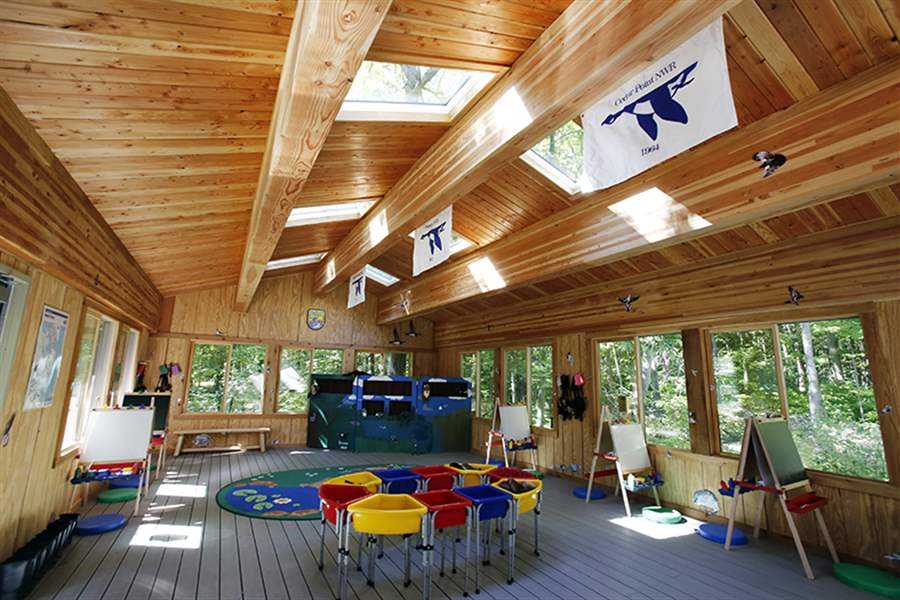
Commentary
Duck stamp program flying high
Maumee Bay State Park hosts competition today, Saturday
9/27/2013
The ranger station at Ottawa National Wildlife Refuge honors the late Bob Hines, a wildlife artist who grew up in Fremont. Hines designed the 1947 Federal Duck Stamp and illustrated more than 50 books.
THE BLADE/JEREMY WADSWORTH
Buy This Image

The ranger station at Ottawa National Wildlife Refuge honors the late Bob Hines, a wildlife artist who grew up in Fremont. Hines designed the 1947 Federal Duck Stamp and illustrated more than 50 books.

Matt Markey.
OAK HARBOR — In the Lake Erie marshes north of here, the Canada geese, the canvasbacks, and the red-breasted mergansers never noticed the difference.
But about 35 years ago, the membership in the official club of the supporters of habitat for waterfowl and wildlife grew by the millions.
Throughout the first four decades of its existence, the Duck Stamp was known as the “Migratory Bird Hunting Stamp,” and it has been a required purchase for waterfowl hunters throughout the U.S.
When the 1977 stamp was issued, depicting a pair of Ross' Geese in flight, it became the “Migratory Bird Hunting and Conservation Stamp.”
Just two additional words, but a huge change.
Nonhunters had likely been supporting the program and its efforts to expand and protect habitat for waterfowl and wildlife for many years before the formal name modification, but with that 1977 stamp, the official investors in wetlands habitat became a much larger flock.
The artwork for the 2014-15 Federal Duck Stamp will be selected during a competition that takes place today and Saturday at Maumee Bay State Park. The selection of this region to host the prestigious event seems very fitting, since for waterfowl hunters, birders, and conservationists, the western Lake Erie marshes are a shared sacred ground.
“We like ducks too, and we recognize that the stamp supports many kinds of wildlife,” said internationally renowned birding expert and author Kenn Kaufman, who served as a judge in the 2005 Duck Stamp competition.
“Wetlands for ducks are also ideal habitats for rails, gallinules, bitterns, grebes, terns, various marsh-loving wrens, and sparrows, and many other birds.”
Since its inception in 1934, the Federal Duck Stamp program has helped protect and conserve more than 6.5 million acres of wetlands and grasslands. The program has generated some $850 million for this effort, a significant contribution to the conservation of America's natural resources.
“The Duck Stamp is a great investment for anyone,” said Paul Schmidt, the chief conservation officer for Ducks Unlimited, the largest private wetlands and waterfowl conservation group in the world. “The habitat and land protection this program is responsible for sustains forever, and these projects benefit not only waterfowl, but all types of wildlife, and humans as well.”
Schmidt emphasized that the marshes and wetlands play a key role in filtering and cleaning water.
“So whether you are a waterfowl hunter and have to buy the Duck Stamp, or a bird watcher, a conservationist, or just someone who values clean water, this is a program we hope you would support,” he said.
Schmidt lauded the success of the Duck Stamp, and its stellar record of putting 98 percent of the funds it generates into habitat and wetlands projects.
“You don’t see many programs run that efficiently,” he said. “It is one of the shining stars of good government.”
Kaufman pointed out that the income from the Duck Stamp program — more than two million of the $15 stamps were produced just last year — is not used exclusively to buy duck habitat.
The money goes into the Migratory Bird Conservation Fund, where it is used to enhance the National Wildlife Refuge System, through either the purchase or leasing of land.
A major portion of the funds used to acquire the property that makes up the Ottawa National Wildlife Refuge along Lake Erie, and that at refuges in Delaware, New Mexico, Texas and North Carolina, came from this same pool of money generated by the sale of the Duck Stamp.
“Birders and wildlife-watchers get far more use out of these refuges than hunters do,” Kaufman said.
He added that many birding organizations, including the Black Swamp Bird Observatory located at the entrance to the Magee Marsh Wildlife Area, sell the stamp, which is also sought by many stamp collectors.
Both Schmidt and Kaufman stressed the importance of the partnership between waterfowl hunters and the birder/conservation groups in supporting the Duck Stamp program, and the wide-ranging benefits its habitat projects provide for wildlife.
“I’m concerned about bird conservation. I worry about what will happen to populations of shorebirds. I worry about what will happen to populations of hawks, woodpeckers, warblers,” Kaufman said. “But I never spend a minute worrying about ducks, because the duck hunters are taking care of them.”
The Duck Stamp competition at Maumee Bay, which is free and open to the pubic, will conclude early Saturday afternoon with the announcement of the winning artwork.
MICHIGAN WOLF LICENSES: Wolf hunting licenses go on sale in Michigan on Saturday at noon. A total of 1,200 licenses are available, and sales will end on Oct. 31, or when the quota is sold out. Wolf licenses cost $100 for Michigan residents and $500 for nonresidents. Licenses will be available at the www.mdnr-elicense.com Web site and at any authorized license agent. The detailed rules for the wolf hunting season are available at www.michigan.gov/dnrdigests.
YELLOW JACKETS: Toledo-area entomologist Russell Lamp is interested in collecting the nests of ground-nesting yellow jackets. He is no longer collecting hornet nests. Contact Lamp at 419-836-3710.
Contact Blade outdoors editor Matt Markey at: mmarkey@theblade.com or 419-724-6068.